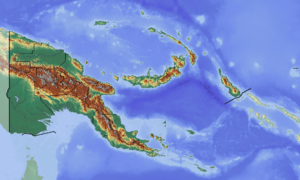Mount Hagen (volcano)
Mount Hagen (German: Hagensberg), named after the German colonial officer Curt von Hagen (1859–1897), is the second highest volcano in Papua New Guinea and on the Australian continent, ranking behind only its neighbour Mount Giluwe which is roughly 35 kilometres (22 mi) to the south-west. It is located on the border between the Western Highlands and Enga Provinces, about 24 kilometres (15 mi) north-west of the city of Mount Hagen which is named after it.
| Mount Hagen | |
|---|---|
 Mount Hagen Western Highlands and Enga Provinces, Papua New Guinea | |
| Highest point | |
| Elevation | 3,778 m (12,395 ft) |
| Prominence | >900 m (3,000 ft) |
| Coordinates | 5°45′S 144°2′E [1] |
| Geography | |
| Location | Western Highlands and Enga Provinces, Papua New Guinea |
| Parent range | Hagen Mountains |
| Geology | |
| Age of rock | 210,000–380,000 years[2] |
| Mountain type | Eroded stratovolcano |
| Last eruption | ~ 210,000 years ago |
Mount Hagen is an old stratovolcano which has been heavily eroded during several Pleistocene glaciations. The maximum extent of the glaciers on Hagen was less than half that on the much higher Mount Giluwe, covering an area of up to 50 km² (20 mi²) and extending down below 3,400 m (11,000 ft).[3]
References
- "Hagen, Mount". GEOnet Names Server. Retrieved 2011-05-17.
- Löffler, E.; Mackenzie, D. E.; Webb, A. W. (1980). "Potassium-argon ages from some of the Papua New Guinea highlands volcanoes, and their relevance to Pleistocene geomorphic history". Journal of the Geological Society of Australia. 26 (7–8): 387–397. Bibcode:1979AuJES..26..387L. doi:10.1080/00167617908729105.
- Mackenzie, D. E. (1985). "Giluwe and Hagen; glaciated volcanoes in the rain forests of western PNG". Volcano News. 19–20: 7.